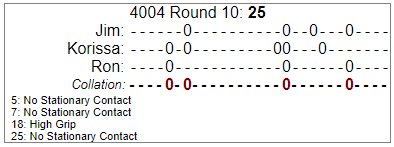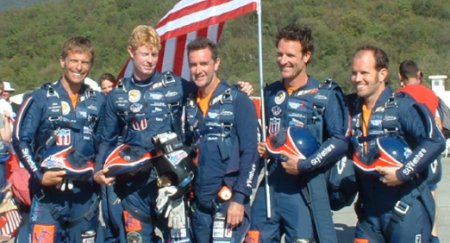
National
Skydiving
League
226 Pecan Street
Deland FL 32724
tel: (386) 801-0804
© 2003 - 2025
All Rights Reserved


226 Pecan Street
Deland FL 32724
tel: (386) 801-0804
© 2003 - 2025
All Rights Reserved


The NSL News reporter was eventually shown the yellow card for using up too much precious time when USPA's Chief Judge Jim Rees agreed to elaborate on a few topics. After the opening with the yellow card, the interview included a lot of relevant information for Formation Skydiving teams and competitors from the judging perspective.
One of the relevant topics was the penalty situation for the visiting 4-way world champions from Belgium, NMP PCH HayaBusa. After nine rounds with only three point deductions, HayaBusa found four red marks on the scoresheet of Round 10. The Belgian team was on the way to skip the 28+ level and post the first 29+ average in history of Formation Skydiving outdoor competition.
![]() The four point deductions in the last round kept the meet average at 28.9 and one point short of the historic mark. However, the 28.9 average was still the first time that a team scored higher than 27.9 which was HayaBusa's previous record number that they held together with Arizona Airspeed since the FAI World Meet 2012 in Dubai.
The four point deductions in the last round kept the meet average at 28.9 and one point short of the historic mark. However, the 28.9 average was still the first time that a team scored higher than 27.9 which was HayaBusa's previous record number that they held together with Arizona Airspeed since the FAI World Meet 2012 in Dubai.

The recent NSL Live Talk with Mark "Stretch" Szulmayer, Chairman of the ISC (International Skydiving Commission) Formation Skydiving Committee, included another topic that was also a major part of the conversation with Jim Rees. He is a member of USPA's Formation Skydiving Committee that was recently in the NSL News headlines after the cancellation and rescheduling of the FAI Mondial Tanay 2020.
Mark Szulmayer and Jim Rees both pointed out separately that the accuracy of the results are their main concern in the judging process. As an FAI and USPA Judge, Jim Rees was able to provide even more details of the judging procedure.
He said that the judging panel now has the 50% review speed available to get to the most accurate results within a reasonable time-frame. The option of slower review speed came up when indoor competition generated significantly higher scoring numbers. Eventually, the rules for outdoor and outdoor judging were synchronized.
USPA Nationals 2019 | 1 | 2 | 3 | 4 | 5 | 6 | 7 | 8 | 9 | 10 | 11 | Total | Avg | |||||||||||||
|---|---|---|---|---|---|---|---|---|---|---|---|---|---|---|---|---|---|---|---|---|---|---|---|---|---|---|
| Rank | 4-way Open Class | 7,C,H,P | J,21,20 | O,3,11 | B,2,K,E | 8,Q,10 | 15,D,F,12 | N,L,M,14 | 6,1,9 | A,18,13 | G,4,5 | 17,16,22 | Total | Avg | ||||||||||||
| 1 | NMP-PCH Hayabusa | BE | 45 | -1 | 24 | 27 | 37 | 21 | 25 | 34 | 25 | -1 | 26 | -1 | 25 | -4 | - | 289 | 28.9 | |||||||
| 2 | SDC Rhythm XP | US | 41 | 22 | 21 | -1 | 33 | 21 | 23 | 27 | 25 | 24 | 25 | 21 | -1 | 262 | 26.2 | |||||||||
| 3 | Arizona Airspeed | US | 40 | -1 | 24 | 22 | -2 | 32 | 19 | -2 | 24 | 29 | 25 | 21 | -2 | 26 | -1 | 20 | -2 | 262 | 26.2 | |||||
| 4 | Defiance | US | 30 | -1 | 21 | 15 | -4 | 28 | 16 | 19 | 22 | -3 | 21 | 18 | -1 | 18 | -1 | - | 208 | 20.8 | ||||||
| 5 | Ranch 2nd Generation | US | 26 | 19 | 19 | 24 | -2 | 16 | -1 | 17 | -1 | 24 | 18 | -1 | 19 | 19 | - | 201 | 20.1 | |||||||
| 6 | Kinetix | AU | 26 | 18 | 17 | 22 | 13 | -1 | 17 | 18 | -1 | 17 | 17 | 17 | - | 182 | 18.2 | |||||||||
| 7 | Lite XP | US | 24 | -1 | 17 | 17 | 22 | 15 | 17 | 20 | -2 | 16 | -1 | 14 | 17 | - | 179 | 17.9 | ||||||||
| 8 | No Name | US | 22 | -4 | 17 | 14 | 19 | -2 | 12 | -2 | 13 | 14 | -3 | 15 | 14 | 16 | - | 156 | 15.6 | |||||||
| 9 | Aviatrixx | US | 21 | 14 | 13 | -1 | 18 | -1 | 12 | -2 | 15 | 17 | -1 | 14 | -1 | 12 | 14 | - | 150 | 15.0 | ||||||
| 10 | Perris Force | US | 20 | 13 | -1 | 14 | 18 | 11 | -1 | 11 | 18 | -1 | 13 | -1 | 12 | 12 | -1 | - | 142 | 14.2 | ||||||

 even apply frame-by-frame judging if it helps the judging accuracy and happens within the needed time-frame for reasonable posting of the scores.
even apply frame-by-frame judging if it helps the judging accuracy and happens within the needed time-frame for reasonable posting of the scores.
There were two major factors in the past that increased scoring level and performance speed. FAI's International Parachuting Commission (IPC) decided after the FAI World Meet 2004 not to punish infringements any longer with an additional point deduction.
This rule change had an impact on the performance, as teams could pick up the speed without too much fear of losing a meet only due to additional point deductions. The scoresheets until 2004 were significantly cleaner compared to the following time periods.
The second serious impact came with the modern wind ![]() tunnels that allowed teams to develop their skills to new performance levels. Especially the top teams invested a lot of time for indoor training, which is now an important training tool for all skydivers. Speed and scoring level increased dramatically, while the judges tried to keep up with the progression. Adjustments came with the introduction of more time for reviews and application of slow-motion viewing. The slow-motion review was gradually adjusted and is now down to 50%. Jim Rees said that frame-by-frame could be a next step to guarantee the most accurate results.
tunnels that allowed teams to develop their skills to new performance levels. Especially the top teams invested a lot of time for indoor training, which is now an important training tool for all skydivers. Speed and scoring level increased dramatically, while the judges tried to keep up with the progression. Adjustments came with the introduction of more time for reviews and application of slow-motion viewing. The slow-motion review was gradually adjusted and is now down to 50%. Jim Rees said that frame-by-frame could be a next step to guarantee the most accurate results.